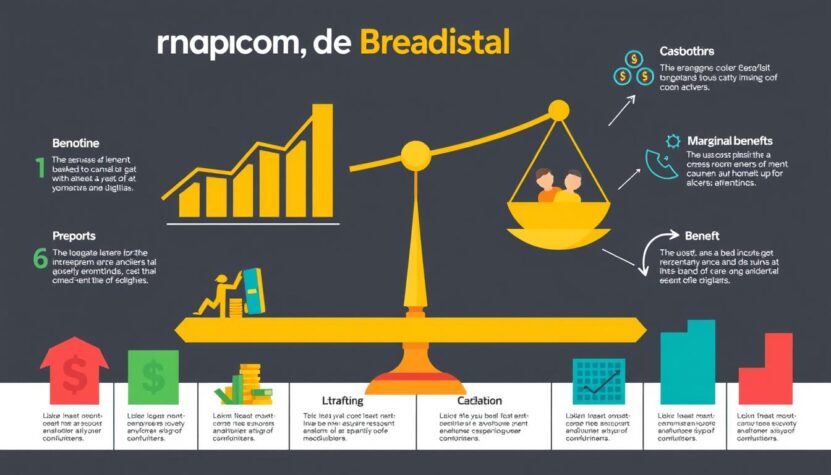As a business owner, understanding how to calculate marginal benefit is essential for making informed decisions that can enhance your profitability and sustainability. Marginal benefit refers to the maximum amount a consumer is willing to pay for one extra unit of a good or service. This concept plays a vital role in guiding your pricing and production strategies, ensuring that you align your offerings with consumer expectations and demand.
By mastering the technique of marginal benefit calculation, you can optimize your financial planning, considering factors such as marginal costs, economies of scale, and consumer preferences. This business owner finance guide will explore the importance of marginal benefit in decision-making processes and equip you with the tools needed to apply these concepts in real-world scenarios. Ultimately, knowing how to calculate marginal benefit can help you maximize profit and allocate resources effectively, leading to long-term success.
Understanding Marginal Benefit
Understanding marginal benefit is essential for making informed business choices. Marginal benefit refers to the highest amount a buyer is willing to pay for one additional unit of a product. This concept often ties closely to understanding marginal utility, which explains how satisfaction changes with each unit consumed. As consumption increases, the marginal benefit typically diminishes, indicating that consumers value extra units less than the previous ones.
Definition of Marginal Benefit
Marginal benefit is measured from the buyer’s perspective. It highlights the cost a consumer is ready to incur for an additional unit of goods. When calculating marginal benefit, one considers that the additional utility or satisfaction derived from consuming an extra unit tends to decrease with each subsequent purchase, encapsulating the law of diminishing marginal utility.
Types of Marginal Benefits
There are three primary types of marginal benefits:
- Positive Marginal Benefit: This occurs when consuming more of a product adds satisfaction or happiness to the consumer.
- Negative Marginal Benefit: This arises when the consumption of additional units leads to negative outcomes, reducing overall satisfaction.
- Zero Marginal Benefit: This occurs when additional consumption brings neither positive nor negative effects, indicating a saturation point in consumption.
The Role of Marginal Benefit in Business Decisions
Understanding marginal benefit is crucial for effective business decisions. Companies utilize this concept to determine optimal pricing strategies and assess consumer satisfaction. By analyzing the relationship between marginal benefit and marginal cost, businesses can find market equilibrium, ensuring efficient production levels. This knowledge directly informs strategies that can enhance profitability and fulfillment of consumer demands, making marginal benefit indispensable in business decisions.
| Type of Marginal Benefit | Description | Impact on Decision Making |
|---|---|---|
| Positive Marginal Benefit | Increases satisfaction with more consumption | Encourages continued production and marketing |
| Negative Marginal Benefit | Decreases satisfaction, leading to potential loss | May necessitate reducing production or altering the product |
| Zero Marginal Benefit | No positive or negative impact from additional consumption | Indicates market saturation, prompting strategic reevaluation |
How to Calculate Marginal Benefit
Understanding how to calculate marginal benefit is crucial for making informed business decisions. This concept involves determining the additional value derived from producing one more unit of a good or service. The formula for marginal benefit is simple yet essential: Marginal Benefit = Change in Benefit ÷ Unit Change. Below is a breakdown of how to effectively calculate marginal benefit and apply it in real-world scenarios.
The Formula for Marginal Benefit
The foundation of calculating marginal benefit lies in the understanding of its formula. It can be expressed as:
Marginal Benefit (MB) = Total Additional Benefit ÷ Total Number of Additional Goods Consumed
This formula highlights the relationship between the benefit gained and the quantity consumed. It shows how calculating marginal cost and benefit helps businesses gauge the economic efficiency of their operations.
Step-by-Step Calculation
To clarify how to calculate marginal benefit, consider a straightforward example. Imagine a company that sells a product. The production of an additional unit provides an extra benefit of $15 to the consumer. If the company produces one additional unit, the change in benefit is $15 and the unit change is 1. Using the formula:
Marginal Benefit = $15 ÷ 1 = $15
This calculation indicates that the consumer is willing to pay up to $15 for that additional unit. The organization can then assess this information against the marginal cost.
Real-World Application of Marginal Benefit
Businesses frequently utilize marginal benefit calculations to optimize pricing strategies and enhance profitability. For instance, if a company identifies that marginal benefit equals marginal cost, it achieves market efficiency and can maximize profits. Studies show that when conducting research on marginal benefits, companies often pinpoint ideal price points, ensuring consumer satisfaction while optimizing operational costs.
Here’s a quick summary of the marginal benefit calculation example in a business context:
| Factor | Details |
|---|---|
| Optimal Additional Production | 200 units |
| Total Incremental Revenue | $13,500 |
| Total Incremental Cost | $10,500 |
| Incremental Profit | $3,000 |

By comparing the marginal benefit to marginal cost, you can ensure sustainable growth and effective decision-making in your business operations. Understanding how to calculate marginal benefit widens your capacity for strategic planning, allowing for better resource allocation and enhanced profitability.
Conclusion
As you have discovered throughout this guide, the process of marginal benefit calculation is crucial for effective decision-making in the business landscape. Understanding marginal utility enables you to evaluate the additional satisfaction gained from each unit consumed or action taken. By recognizing the differences in marginal benefit for various scenarios, you can better assess the potential outcomes and make informed choices that align with your business goals.
In our example, the values of marginal benefits and costs illustrate the importance of maximizing net benefits. With a marginal benefit of $20 for the first drink, $12 for the second, and a diminishing return of $6 for the third, the insights gained from marginal analysis become clear. Once total benefits rise above total costs, such as in the scenario of purchasing two drinks where there’s an $18 net benefit, you know you’re making a favorable economic choice.
Ultimately, the key lesson here is that while understanding marginal benefit helps clarify your options, recognizing when marginal benefit equals marginal cost is essential for achieving market efficiency. Striving to maintain positive marginal net benefits will lead to more profitable decisions, solidifying a strong competitive edge in a dynamic market environment. Equip yourself with these insights, and let them inform your strategy for sustained business growth.
Related Posts:
- Acquisition Cost Meaning - How to Calculate and Use…
- How to Sell a Small Business by Owner? The Complete…
- What Are Royalties in Business? A Complete Guide for…
- The Overseas Shopper’s Guide to Japanese Goodies - 9…
- Choosing the Best Fabric for Your Baby Carrier - A…
- Complete Professional Photo Background Guide for…









